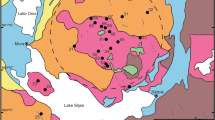Abstract
Ion microprobe U-Th-Pb isotopic analyses of zircons from a granodioritic orthogneiss from the Napier Complex, Mount Sones, Enderby Land, Antarctica, have identified an unambiguous example of unsupported radiogenic Pb in a 3,950 Ma-old crystal. At one 40 μm spot on the crystal an unusually large heterogeneity in Pb content was found, the concentration of radiogenic Pb ranging from 5 to 50 percent higher than could have been generated in 3,950 Ma by radioactive decay of the co-existing U and Th. This relative excess of radiogenic Pb is attributed to Pb gain rather than to U and Th loss because first, the Pb content varied by more than the U or Th contents and secondly, changes in the Pb/U, Pb/Th and Pb isotopic composition correlated directly with changes in the Pb concentration. The individual 207Pb/206Pb apparent ages ranged from 4,000 Ma to 4,145 Ma, all greater than the inferred age of the crystal. A correlation between 207Pb/206Pb and Pb/U shows that the Pb excess has not resulted from recent Pb movement. The spot apparently gained radiogenic Pb about 2,500 Ma ago, at the same time as the majority of the other zircons in the rock suffered substantial Pb loss. The Pb movement occurred in response to a discrete geologic event. Reverse discordance is a phenomenon that must be considered when interpreting zircon U-Pb ages, especially 207Pb/206Pb ages of single crystals or portions of crystals.
Similar content being viewed by others
References
Black LP, James PR (1983) Geological history of the Archaean Napier Complex of Enderby Land. In: Oliver RL, James PR, Jago JB (eds) Antarctic Earth Science. Australian Academy of Science, Canberra, pp 11–15
Black LP, James PR, Harley SL (1983) Geochronology and geological evolution of metamorphic rocks in the Field Islands area, East Antarctica. J Metamorphic Geol 1:277–303
Compston W, Williams IS, Clement SW (1982) U-Pb ages within single zircons using a sensitive high mass-resolution ion microprobe. Am Soc Mass Spectrom Conf 30th, Honolulu, 593–5
Compston W, Williams IS, Meyer C (1984) U-Pb geochronology of zircons from lunar breccia 73217 using a sensitive high massresolution ion microprobe. J Geophys Res 89 Supplement: B525–B534
Froude DO, Ireland TR, Kinny PD, Williams IS, Compston W, Williams IR, Myers JS (1983) Ion microprobe identification of 4,100–4,200 Myr-old terrestrial zircons. Nature 304:616–618
Gebauer D, Grünenfelder M (1976) U-Pb zircon and Rb-Sr whole-rock dating of low grade metasediments. Example: Montagne Noire (Southern France). Contrib Mineral Petrol 59:13–32
Higgins MW, Sinha AK, Zartman RE, Kirk WS (1977) U-Pb zircon dates from the central Appalachian Piedmont: A possible case of inherited radiogenic lead. Geol Soc Am Bull 88:125–132
Lancelot J, Vitrac A, Allègre CJ (1976) Uranium and lead isotopic dating with grain by grain zircon analysis: a study of complex geological history with a single rock. Earth Planet Sci Lett 29:357–366
Oosthuyzen EJ, Burger AJ (1973) The suitability of apatite as an age indicator by the uranium-lead isotope method. Earth Planet Sci Lett 18:29–36
Pidgeon RT, O'Neil JR, Silver LT (1966) Uranium and lead isotopic stability in a metamict zircon under experimental hydrothermal conditions. Science 154:1538–1540
Pin C, Lancelot J (1982) U-Pb dating of an Early Palaeozoic bimodal magmatism in the French Massif Central and its further metamorphic evolution. Contrib Mineral Petrol 79:1–12
Sheraton JW, Black LP (1983) Geochemistry of Precambrian gneisses: relevance for the evolution of the East Antarctic Shield. Lithos 16:273–296
Sinha AK, Glover L, Higgins MW, Hart SR, Davis GL, Kirk WS (1971) U/Pb dating of volcanism in the Central Piedmont (Carolina Slate Belt). Carnegie Inst Wash Yearb 69:408–412
Steiger RH, Jaeger E (1977) Subcommission on geochronology: Convention on the use of decay constants in geo- and cosmochronology. Earth Planet Sci Lett 36:359–362
Author information
Authors and Affiliations
Additional information
Decay constants. Ages in this paper are calculated using the decay constant convention recommended by the Subcommission on Geochronology (Steiger and Jaeger 1977).
Rights and permissions
About this article
Cite this article
Williams, I.S., Compston, W., Black, L.P. et al. Unsupported radiogenic Pb in zircon: a cause of anomalously high Pb-Pb, U-Pb and Th-Pb ages. Contr. Mineral. and Petrol. 88, 322–327 (1984). https://doi.org/10.1007/BF00376756
Received:
Accepted:
Issue Date:
DOI: https://doi.org/10.1007/BF00376756




